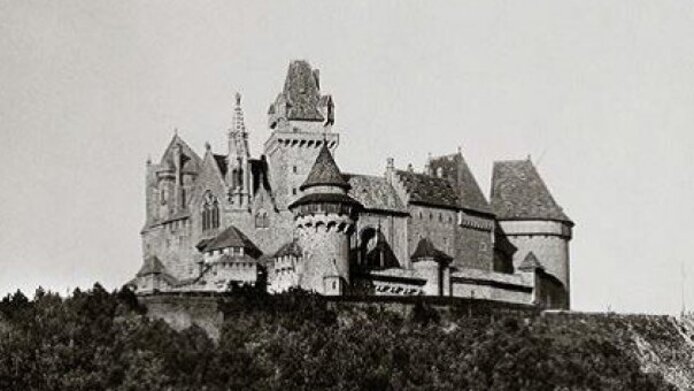Kreuzenstein – fictitious Middle Ages all real

Visible from afar, a huge imposing building offering a picturesque view of the River Danube. A fairy-tale castle. – This is more or less how one can also describe the way it came into being. For, Kreuzenstein near Korneuburg in Lower Austria is not a genuine medieval castle, but was built from 1874 until 1906 commissioned by Count Johann Nepomuk Wilczek as a family mausoleum and private museum. The “foundations” for this enormous structure were the remains of walls and a few pieces of masonry left from the original structure dating from the 12th century. As a medieval reconstruction the building failed to attract the interest of science for a long time, no matter how much it may have been and still is appreciated by the general public and as a film set.
Most important castle from the Historicist period
Acclaimed as one of the “most beautiful Austrian books”, the publication by Andreas Nierhaus entitled Kreuzenstein – Die mittelalterliche Burg als Konstruktion der Moderne is now available in print. It is the result of intense basic research on the basis of sources that turned out to be very limited in scope. This being said, the art historian Andreas Nierhaus succeeded in crafting a comprehensive account, partly based on historical photographs by Wilhelm Burger, of the castle, its history, architecture and furnishings. Andreas Nierhaus was thus the first to embed the modern-age castle of Kreuzenstein in a larger art history and cultural context and also demonstrate its importance for today’s popular concepts of the Middle Ages.
“The castle is one of the most important of its time”, says Nierhaus. This is particularly due to the fact that the man who had it built, Count Wilczek, was an avid collector of building elements, so-called spolia, stemming from works of art and other objects from the Middle Ages. “In the 19th century there was no other structure in the world that included so many parts from other buildings”, says Nierhaus as he explains the intriguing appeal of the castle. In order to reconstruct what was thought to be medieval authenticity, the builders spared neither work nor money. A Slovakian organ gallery, for instance, was brought in for an arcaded hallway, the wood came from farmhouses in Tyrol and roof slates from the famous Basel Cathedral.
The castle Kreuzenstein near Korneuburg in Lower Austria was erected between 1874 and 1906, commissioned by Count Hans Wilczek. Andreas Nierhaus presents the first comprehensive study of the building, its history, architecture and interior furnishings.
HIs book shows how Kreuzenstein has marked and continues to mark the public’s ideas of a medieval castle. The castle is also a popular location for the movie industry.
The birth of modern theme parks
Andreas Nierhaus views Kreuzenstein as a time machine “that continues to offer a virtual trip to the past”. Visiting Kreuzenstein is like ‘beaming’ yourself to the Middle Ages and back again. The love of knights, armour and battlements originated right then, in the 19th century and had to do with the sea changes occurring at the time. People yearned for the return of clear structures and order. Hence, Kreuzenstein was a popular destination for outings right from the start. Visitors not only included the general public, the place was also a first-rate sightseeing destination for important guests of state such as Emperor Kaiser Wilhelm II or US President Theodore Roosevelt. The Middle Ages, as imagined in the 19th century, were brought to life by the castle like a 3-D historical image. Nierhaus also relates this phenomenon to the emergence of mass entertainment in the shape of modern theme parks such as Venedig in Wien (Venice in Vienna), an amusement park that opened in the Prater in 1895.
Links to the present
“Kreuzenstein is the product of an era that in many respects provided the basis for today’s culture”, notes Nierhaus and cites bourgeois society, museum, theatre, cinema and photography as examples. This means there are many links reaching till today. Take film as an example. Kreuzenstein was and is a place where movie history is written, most recently by the US television series The Quest. Nierhaus explains that an exploration of the 19th century perspective on the Middle Ages meant understanding the way in which the modern Middle Ages were instrumentalised for politics and societal issues. “This image can be recharged continuously”, says the author.
Medieval castles are still being built today, as they were in the 19th century, and sometimes they are used for building national identity. The significance of material traces of the past is unbroken to this day. “I was surprised by how powerful such an object can be, just because you know that it has old roots”, is how Nierhaus describes one of the insights gained from his research. “The way the place is charged with an aura of such density was almost frightening. This is something one could explore further”, comments the author. Indeed, there are many themes in the book that would merit further attention. With the Kreuzenstein project the art historian has laid an important foundation. The large chapter about spolia could be the starting point for further analysis of this topic. The castle is also home to a valuable art collection which has not been the subject of research so far.
Andreas Nierhaus is an art historian and has been curator of the architectural collection of the Wien Museum since 2008. His research focuses on architecture and the visual arts in the 19th and 20th centuries, Historicism and Modernism, as well as media of architecture and architectural drawings.
The publication
Andreas Nierhaus: Kreuzenstein – Die mittelalterliche Burg als Konstruktion der Moderne, Böhlau 2014 - also available at the FWF e-book library: http://e-book.fwf.ac.at/o:562





